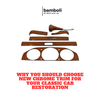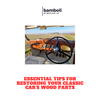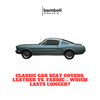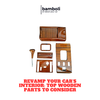Essential Tips for Restoring Your Classic Car’s Wood Parts
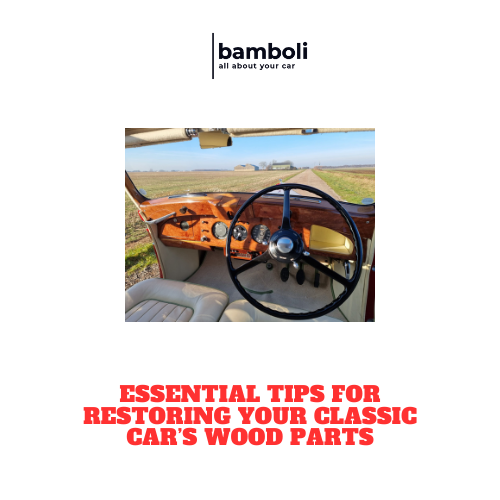
Essential Tips for Restoring Your Classic Car’s Wood Parts
When restoring a classic car, it’s crucial to pay special attention to its wooden components. Wood parts, such as dashboards, door trims, or steering wheels, add unique character to your classic car, but they also pose restoration challenges. While it may seem tempting to repair damaged wood, in many cases, replacing these parts with new, high-quality ones can be the smarter choice. Here are essential tips to guide you through the restoration process, with a focus on why purchasing new wood parts is often more efficient and advantageous.
1. Assess the Condition of the Wood
Before deciding how to proceed, evaluate the condition of the wood. Classic cars can suffer from a variety of wood-related issues:
- Cracks or Splits: Even small cracks can weaken the structural integrity of wood parts.
- Rot and Decay: This is particularly common in wood exposed to moisture over time.
- Warping: Wood that has been exposed to heat or humidity can become deformed, making it difficult to fit back into place.
Why Replacement is Better:
- Repairing cracks often requires special tools and can be time-consuming. The end result may not restore the wood’s original strength or appearance.
- Replacing wood parts ensures you get a brand-new component that fits perfectly and is free from defects. A new part will maintain its shape and quality much longer than a repaired one.
2. Cost and Effort: Repair vs. Replace
The decision to repair or replace your wood parts often comes down to cost and effort. While repairs may seem more affordable at first glance, the time, labor, and potential for imperfect results make replacement a more attractive option.
Challenges of Repair:
- Specialized Tools Needed: Repairs often require tools such as wood fillers, clamps, and sanders.
- Skill Level: Wood restoration demands a high level of craftsmanship to match the car’s original aesthetic.
- Inconsistent Results: Repairs can be unpredictable. Even after hours of work, you may find that the wood doesn’t match the rest of the car or fails to hold up over time.
Advantages of New Parts:
- Immediate Availability: Purchasing new parts saves time, allowing you to focus on the installation rather than an extended repair process.
- Guaranteed Fit and Finish: Modern manufacturing ensures that new wood parts are crafted to the exact specifications of your classic car, offering a flawless fit.
- Durability: New parts are designed to last, with improved protection against common issues like warping and cracking.
3. Authenticity and Aesthetic Value
When it comes to classic car restoration, maintaining the vehicle’s authenticity is key. Many purists aim to preserve the original wood, but for those seeking an easier and more consistent solution, replacing wood parts with new, high-quality replicas is a practical alternative.
Why New Parts Enhance Value:
- Perfect Match: New wood parts can be sourced or custom-made to match the original grain, texture, and finish of your car, ensuring that the aesthetic remains true to the original design.
- No Patchwork Repairs: Repaired wood can look uneven or show signs of filler, detracting from the overall appearance of the car.
- Added Strength: Modern wood treatments and finishing techniques make new parts more resistant to moisture and damage, enhancing the longevity of the car’s interior.
4. Ease of Maintenance
Replacing wood parts also simplifies future maintenance. While repaired wood may need constant upkeep to prevent further damage, new parts are often treated with modern protective coatings that require less frequent maintenance.
Low Maintenance of New Parts:
- UV-Resistant Coatings: Many new wood parts come pre-treated with UV-resistant coatings to prevent fading and sun damage.
- Moisture Protection: Unlike older wood that may be vulnerable to rot or mildew, new parts are often sealed to resist moisture infiltration.
Conclusion
While the idea of repairing your classic car’s wood parts might seem appealing, it often leads to more headaches than solutions. Replacing damaged or worn wood components with brand-new parts is the more practical, cost-effective, and aesthetically pleasing option. Not only does this save time and reduce the complexity of restoration, but it also ensures that your classic car retains its value and beauty for years to come. By opting for new parts, you gain durability, authenticity, and peace of mind that your restoration is built to last.
Repairing vs. Replacing Wood Parts - Quick Comparison Table
|
Aspect |
Repair |
Replace |
|
Cost |
May seem cheaper initially but requires additional tools and materials |
One-time investment with no hidden costs |
|
Time |
Lengthy process, especially for cracks and rot |
Faster—parts are ready to install |
|
Durability |
Repaired wood may deteriorate again over time |
New parts are built to last with modern materials and treatments |
|
Aesthetic |
Risk of inconsistent finish or mismatched grain |
Perfectly matches original design with a flawless finish |
